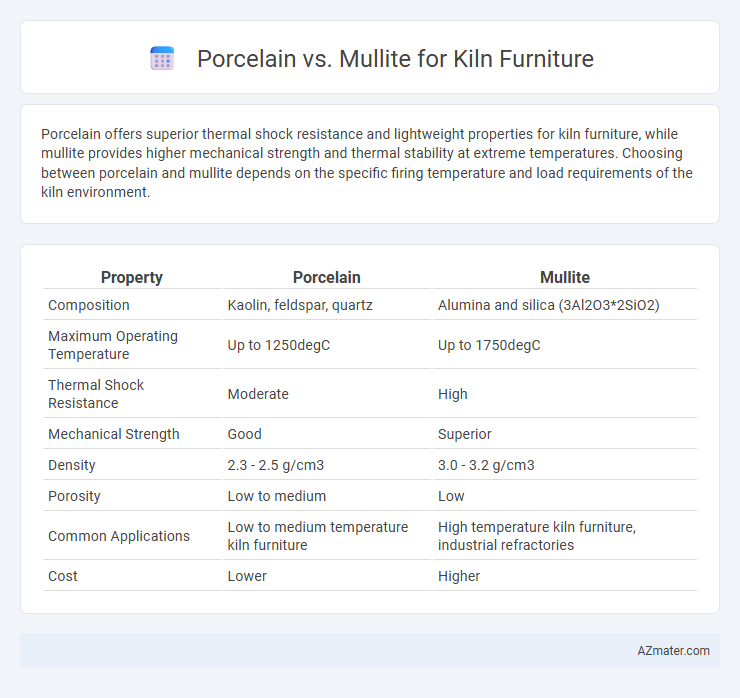Porcelain offers superior thermal shock resistance and lightweight properties for kiln furniture, while mullite provides higher mechanical strength and thermal stability at extreme temperatures. Choosing between porcelain and mullite depends on the specific firing temperature and load requirements of the kiln environment.
Table of Comparison
| Property | Porcelain | Mullite |
|---|---|---|
| Composition | Kaolin, feldspar, quartz | Alumina and silica (3Al2O3*2SiO2) |
| Maximum Operating Temperature | Up to 1250degC | Up to 1750degC |
| Thermal Shock Resistance | Moderate | High |
| Mechanical Strength | Good | Superior |
| Density | 2.3 - 2.5 g/cm3 | 3.0 - 3.2 g/cm3 |
| Porosity | Low to medium | Low |
| Common Applications | Low to medium temperature kiln furniture | High temperature kiln furniture, industrial refractories |
| Cost | Lower | Higher |
Introduction to Kiln Furniture Materials
Porcelain and mullite are two primary materials used in kiln furniture, each offering distinct thermal and mechanical properties essential for high-temperature firing processes. Porcelain is favored for its smooth surface, low thermal expansion, and excellent resistance to chemical attack, making it suitable for delicate ceramic work and precision firing. Mullite, a mineral comprising alumina and silica, provides superior thermal shock resistance and durability under extreme heat, often chosen for industrial applications requiring prolonged high-temperature exposure.
Overview of Porcelain as Kiln Furniture
Porcelain kiln furniture offers high thermal shock resistance and fine dimensional stability, making it suitable for precision firing applications. Its dense, non-porous structure minimizes contamination risks and ensures consistent heat distribution within kilns. Porcelain's moderate mechanical strength and smooth surface make it ideal for delicate ceramic and glass firing processes, balancing durability with minimal interaction with kiln atmospheres.
Overview of Mullite as Kiln Furniture
Mullite, a high-temperature ceramic material, offers exceptional thermal stability and mechanical strength, making it ideal for kiln furniture in industrial applications. Its superior resistance to thermal shock and chemical corrosion ensures prolonged durability during repeated firing cycles at temperatures exceeding 1700degC. Compared to porcelain, mullite provides enhanced structural integrity and minimal deformation, optimizing efficiency in high-temperature kiln environments.
Thermal Stability: Porcelain vs Mullite
Mullite exhibits superior thermal stability compared to porcelain, maintaining its structural integrity at temperatures exceeding 1750degC, making it ideal for high-temperature kiln furniture applications. Porcelain, while economically viable and offering good thermal shock resistance up to approximately 1300degC, tends to soften and deform under prolonged exposure to extreme heat. The enhanced thermal stability of mullite minimizes warping and extends the lifespan of kiln furniture used in demanding firing environments.
Mechanical Strength Comparison
Mullite exhibits superior mechanical strength compared to porcelain, making it more resistant to thermal shock and mechanical wear in kiln furniture applications. Porcelain tends to have lower fracture toughness and susceptibility to cracking under high-temperature cycling, while mullite maintains structural integrity at temperatures above 1700degC. This enhanced durability ensures longer service life and stability for kiln furniture components like shelves and setters.
Resistance to Chemical Attack
Mullite exhibits superior resistance to chemical attack compared to porcelain, making it ideal for kiln furniture exposed to aggressive environments. The high alumina content in mullite enhances its stability against fluxes and slags, reducing deterioration during high-temperature firing processes. Porcelain, while durable, is more susceptible to corrosion and chemical wear, limiting its lifespan in chemically aggressive kiln atmospheres.
Weight and Structural Considerations
Porcelain kiln furniture is lighter, offering easier handling and reduced shipping costs, but it lacks the high-temperature strength and resistance to thermal shock found in mullite. Mullite structures provide superior mechanical strength and durability, making them ideal for heavy loads and prolonged kiln use despite their heavier weight. Choosing between porcelain and mullite depends on balancing weight benefits against structural performance requirements in high-temperature environments.
Cost Analysis: Porcelain vs Mullite
Porcelain kiln furniture offers a lower initial cost compared to mullite, making it a budget-friendly option for short-term or low-temperature firing. Mullite, though more expensive upfront, provides superior thermal shock resistance and longevity, resulting in lower replacement frequency and overall cost efficiency in high-temperature or frequent firing scenarios. Evaluating the total cost of ownership, including durability and performance, mullite often proves more economical for intensive kiln use.
Lifespan and Maintenance Requirements
Mullite kiln furniture offers a significantly longer lifespan compared to porcelain due to its superior thermal shock resistance and mechanical strength, reducing the need for frequent replacements in high-temperature firing environments. Porcelain requires more careful handling and regular maintenance to prevent chipping and cracking, especially under rapid temperature changes, which can increase downtime and operational costs. Choosing mullite kiln furniture optimizes durability and minimizes maintenance efforts, enhancing overall kiln efficiency and productivity.
Best Applications: Choosing the Right Material
Porcelain kiln furniture excels in applications requiring smooth surface finishes and moderate thermal shock resistance, making it ideal for low-temperature firing and delicate ceramic pieces. Mullite kiln furniture is favored in high-temperature environments due to its superior thermal stability, strength, and resistance to thermal shock, perfect for heavy-duty ceramics and industrial firing processes. Selecting the right material depends on the kiln temperature range, load weight, and the specific thermal cycling demands of the firing process.

Infographic: Porcelain vs Mullite for Kiln Furniture
 azmater.com
azmater.com